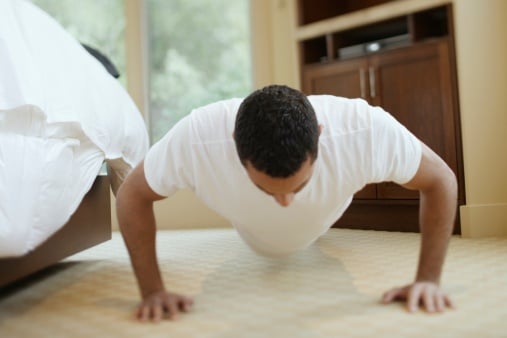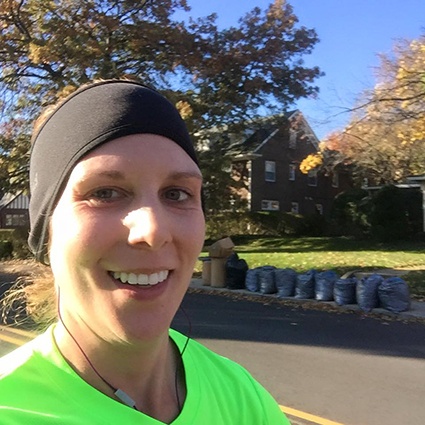 So many people have been expectantly waiting for this hot summer weather to be able to get outside for their workouts. And I can tell you that I am also one of those people; but there are some dangers behind the dog days of summer that we all need to be aware of.
So many people have been expectantly waiting for this hot summer weather to be able to get outside for their workouts. And I can tell you that I am also one of those people; but there are some dangers behind the dog days of summer that we all need to be aware of.
Taking your exercise outside is an awesome idea, but I wouldn’t cancel that gym membership so fast. Let’s take a look at both the dangers of the steamy outdoor workouts and ideas on how to stay cool.
Why Outdoor Exercise Can Be Dangerous in Hot Weather
When the temperatures and humidity rise, working out outside can become dangerous, and it can happen very quickly without anyone even realizing it. The hotter and more humid it becomes, the more you sweat, and the sweat cannot evaporate as quickly as it should. Because of this, your internal body temperature rises and can become deadly.
Some warning signs and symptoms of reaching that dangerous and potentially deadly state are weakness, dizziness, muscle cramps, confusion, headache, increased heart rate, and vomiting.
How to Keep Cool for Summer Workouts
But there are some ways that we can help ourselves during the dog days of summer if you do choose to work out outside. Take a close look at this list and consider taking these steps:
- Hydrate, Hydrate, Hydrate. Drink as much water as possible for proper hydration.
- Wear sunscreen. Lather up with sunscreen to protect your skin.
- Wear sunglasses. This important piece of equipment protects your eyes and conserves energy.
- Get the proper clothing. You want to wear light and loose, moisture-wicking clothing.
- Consume the proper nutrition. Eat a well-balanced diet, and make sure to eat something small before you head out for a long run or Bootcamp class.
- Check the air quality. This is important because it affects how you breathe. The higher the level of AQ, the harder it will be to breathe; the lower, the better. According to EPA standards, if the air quality number is over 100, it’s not good. If it’s below 100, it’s considered satisfactory air level.
- Stay out of the sun. Look for shade to work out in.
- Monitor your heart rate. If it gets too high, take a break.
- Listen to your body. If your body is telling you stop or it’s too hot, listen to it!
- Stay inside if it’s above 90. It’s better to hit the gym than to put yourself in danger.
- Bring water to your workout. Try to keep hydrating yourself as you work out; don’t wait until you are thirsty.
- Cool towels help. Take a cool, damp towel and put it over your head or around your neck.
- Wear a loose-fitting hat. Wearing a tight hat holds the heat to your head, so in order to protect yourself from the sun, wear a loose-fitting hat that allows your head to breathe.
If you do decide to work out outside in the dog days of summer, do the best you can to take the proper precautions and protect yourself from harm. Listen to your body and be sure not to over-do it!
This blog was written by Amanda Bireline, Fitness Center Manager. To find out more about the NIFS bloggers, click here.






 With the rapid development of technology, apps for our smartphones are grabbing our attention. In the growing world of hands and eyes being permanently glued to the cell phone, I have to admit that it’s not all bad! Some of our staff here at NIFS would add to the list of helpful apps one that could be a potential lifesaver—it’s called ICE.
With the rapid development of technology, apps for our smartphones are grabbing our attention. In the growing world of hands and eyes being permanently glued to the cell phone, I have to admit that it’s not all bad! Some of our staff here at NIFS would add to the list of helpful apps one that could be a potential lifesaver—it’s called ICE. My first thought after discovering what this was all about was, “Okay, that sounds kind of cool, but that’s a lot of personal information potentially being displayed for all to see if they got ahold of my phone.” But in early February, an emergency event occurred in the
My first thought after discovering what this was all about was, “Okay, that sounds kind of cool, but that’s a lot of personal information potentially being displayed for all to see if they got ahold of my phone.” But in early February, an emergency event occurred in the  There are so many things in life that can affect different aspects of the human body, and stress is one of the biggest! During a stressful time in life, the body can undergo several physiological changes that can be detrimental to your overall health. Though sometimes we cannot avoid certain stressors that fall into our path of life, there are some things that can be done to help you cope during those times.
There are so many things in life that can affect different aspects of the human body, and stress is one of the biggest! During a stressful time in life, the body can undergo several physiological changes that can be detrimental to your overall health. Though sometimes we cannot avoid certain stressors that fall into our path of life, there are some things that can be done to help you cope during those times.  In October 2014, Allison Griner decided to join
In October 2014, Allison Griner decided to join  Okay, so maybe you’re not a morning person, and would much rather remain cozy in your queen-sized bed for several hours after waking up before finally finding the energy and motivation to make your way to the gym during the middle of the day. Maybe you’re the type of person who likes to take care of your priorities first during the day, and then only if left with enough time sneak in a late-afternoon or nighttime workout before ending your day.
Okay, so maybe you’re not a morning person, and would much rather remain cozy in your queen-sized bed for several hours after waking up before finally finding the energy and motivation to make your way to the gym during the middle of the day. Maybe you’re the type of person who likes to take care of your priorities first during the day, and then only if left with enough time sneak in a late-afternoon or nighttime workout before ending your day.
 As we approach
As we approach 
 Weight loss tends to be one of the most controversial topics talked about, but I want to take a positive approach. With the new year right here, weight loss tops the list of many people’s New Year’s resolutions.
Weight loss tends to be one of the most controversial topics talked about, but I want to take a positive approach. With the new year right here, weight loss tops the list of many people’s New Year’s resolutions. 

 Have you ever gone into the gym and jumped right into your workout, only to notice that it took a good 20 minutes to get into it? Or how about heading out for a run without any form of warming up, and you really don’t start to feel into your rhythm until halfway through?
Have you ever gone into the gym and jumped right into your workout, only to notice that it took a good 20 minutes to get into it? Or how about heading out for a run without any form of warming up, and you really don’t start to feel into your rhythm until halfway through?  I am not someone who is really into New Year’s resolutions. I prefer to use the term “goal” when thinking about next year. When looking ahead, everyone is always trying to make some sort of health and fitness resolution (which for some is awesome and works), but we all know that come the end of February to mid-March, many have fallen off the bandwagon already.
I am not someone who is really into New Year’s resolutions. I prefer to use the term “goal” when thinking about next year. When looking ahead, everyone is always trying to make some sort of health and fitness resolution (which for some is awesome and works), but we all know that come the end of February to mid-March, many have fallen off the bandwagon already. 